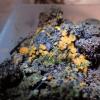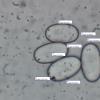
12-01-2026 22:02
Ethan CrensonHello all, I am hoping someone will have some ins

11-01-2026 20:35
Hello.A very tiny pyrenomycete sprouting sparsely

13-01-2026 18:55
Rees CronceStrossmayeria sp. on indet. decroticate hardwoodTh

13-01-2026 07:57
 Danny Newman
Danny Newman
cf. Bombardia on indet. decorticate woodAppalachia

13-01-2026 10:13
 Danny Newman
Danny Newman
Cordieritidaceae sp. on indet. wood w/ Hypoxylon s

13-01-2026 07:28
 Danny Newman
Danny Newman
Chlorociboria glauca on indet. decorticate logThe

13-01-2026 07:14
 Danny Newman
Danny Newman
Neodasyscypha cerina on indet decorticate logThe S

13-01-2026 09:10
 Danny Newman
Danny Newman
Dasyscyphella chrysotexta on indet. decorticate ha

13-01-2026 08:43
 Danny Newman
Danny Newman
Tricladium varicosporioides on indet. decorticate

13-01-2026 08:49
 Danny Newman
Danny Newman
Coccomyces sp. on fallen Rhododendron leavesPretty
Kotlabaea?
Malcolm Greaves,
27-04-2023 18:52
A small group of these were found in a patch of damp soil. Orange/Yellow Spores were smooth with no internal guttules. and were 15-16.5 x 9-9.7. Asci had no reaction to Meltzers. Paraphyses were granular and swollen at the apex.
This suggested Kotlabaea deformis.
I struggled to see the granular contents of the spores which Kotlabaea is supposed to have. I then also found a few septate hairs but this species should not have them. I did notice that the entry for this species in the Database does show minute hairs and although the sketches show them as non-septate the description given mentions septa.
Is this likely to be Kotlabaea or am I missing another species.
Thanks
Mal
Uwe Lindemann,
27-04-2023 19:18
Re : Kotlabaea?
Hello Malcom,
this is not K. deformis. It has ascospores with many small guttules, paraphyses with red pigment droplets and is macroscopically red (seldomly yellow) and has no hairs.
Look at this paper: https://www.researchgate.net/publication/281525896_Revision_der_Gattung_Kotlabaea_K_deformis_K_delectans_und_K_benkertii
I would think of a Cheilymenia species.
Best,
Uwe
this is not K. deformis. It has ascospores with many small guttules, paraphyses with red pigment droplets and is macroscopically red (seldomly yellow) and has no hairs.
Look at this paper: https://www.researchgate.net/publication/281525896_Revision_der_Gattung_Kotlabaea_K_deformis_K_delectans_und_K_benkertii
I would think of a Cheilymenia species.
Best,
Uwe
Malcolm Greaves,
27-04-2023 21:49
Re : Kotlabaea?
Thanks Uwe
Although my find is a shade more orange than the photo shows it is nowhere near the deep orange as shown in your paper. There were only one or two hairs on the outer surface and could easily have been missed but I will go to the Cheilymenia key now.
Mal
Although my find is a shade more orange than the photo shows it is nowhere near the deep orange as shown in your paper. There were only one or two hairs on the outer surface and could easily have been missed but I will go to the Cheilymenia key now.
Mal




 Hairs
Hairs